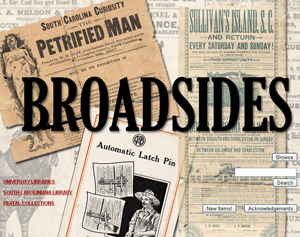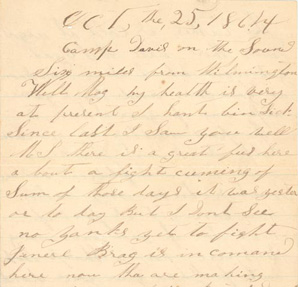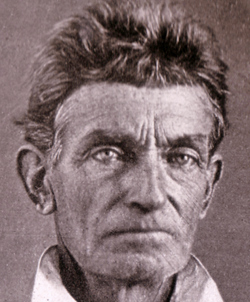I already described DocSouth’s online exhibit on antebellum students at UNC-Chapel Hill, but this letter from March 1861 provides an interesting example of the Upper South’s role in the secession crisis. Even though “Lincoln’s inaugural…amounts to coersion [sic],” John Halliburton believed that “[he could] hate him and still love the Union.” Pro-secession editorials were “absurdities,” as Halliburton noted. Of course many southerners reached similar conclusions. The Fayetteville Observer reported in February 1861 that Tennessee voters “not only [gave] an overwhelming majority for the Union candidates, but voted down the [Secession] Convention itself.” Yet their support for the Union was not unconditional. Disunion remained an option under the right conditions. While the Observer never expected any “violation of [the South’s] rights from [Lincoln’s] administration,” this conditional unionist newspaper considered secession a legitimate response. After Confederates attacked Fort Sumter and President Lincoln called for 75,000 volunteers in April 1861, North Carolina left the Union and Halliburton presumably changed his mind as he enlisted in the Confederate army later that year.
5
Mar
10
Upper South and the Secession Crisis
Posted by sailerd Published in Antebellum (1840-1861), Letters & Diaries Themes: Education & Culture, Slavery & Abolition2
Mar
10
Lincoln at Cooper Union
Posted by Published in Antebellum (1840-1861), Letters & Diaries Themes: Contests & Elections On February 27, 1860, Abraham Lincoln made a landmark speech in his political career at the Cooper Institute in Manhattan, now known as the Cooper Union Address. This speech catapulted the Illinois senator onto the national scene and Lincoln scholars such as Harold Holzer believe that this speech secured his nomination as the Republican party candidate. By extension, this address is seen as a pivotal moment in 1860 that made Lincoln president. Whether or not this was the moment that Lincoln secured his presidency, the speech is critical to any study of the election of 1860. It introduced Lincoln to an audience in the East and caught the attention of Republican party leaders there as well. Lincoln chose to discuss the views of the framers of the Constitution on slavery and states’ rights, a topic that required a great deal of in-depth research. The speech is heavily grounded in historical fact, and shows Lincoln’s ability to articulate his ideas in a clear, logical fashion. In addition to the speech, a photograph (seen at right) taken of Lincoln before the address by Matthew Brady became crucial to the presidential campaign as many campaign posters were based on it. In compiling its digital exhibition celebrating Lincoln’s bicentennial entitled With Malice Towards None, the Library of Congress included the Cooper Union Address and the Cooper Union Portrait in its section on the Road to the Nomination. This project contains an 1860 copy of the speech as campaign literature.
On February 27, 1860, Abraham Lincoln made a landmark speech in his political career at the Cooper Institute in Manhattan, now known as the Cooper Union Address. This speech catapulted the Illinois senator onto the national scene and Lincoln scholars such as Harold Holzer believe that this speech secured his nomination as the Republican party candidate. By extension, this address is seen as a pivotal moment in 1860 that made Lincoln president. Whether or not this was the moment that Lincoln secured his presidency, the speech is critical to any study of the election of 1860. It introduced Lincoln to an audience in the East and caught the attention of Republican party leaders there as well. Lincoln chose to discuss the views of the framers of the Constitution on slavery and states’ rights, a topic that required a great deal of in-depth research. The speech is heavily grounded in historical fact, and shows Lincoln’s ability to articulate his ideas in a clear, logical fashion. In addition to the speech, a photograph (seen at right) taken of Lincoln before the address by Matthew Brady became crucial to the presidential campaign as many campaign posters were based on it. In compiling its digital exhibition celebrating Lincoln’s bicentennial entitled With Malice Towards None, the Library of Congress included the Cooper Union Address and the Cooper Union Portrait in its section on the Road to the Nomination. This project contains an 1860 copy of the speech as campaign literature.
1
Mar
10
 “Under the Rebel Flag: Life in Texas during the Civil War” is a new online exhibit available from the Texas State Library & Archives Commission. Even though it focuses is on a single state, teachers from across the country should be able to find material to use in their classrooms. The exhibit breaks down this period into nine sections that provide concise overviews of major topics and key events. Relevant primary sources, including historical images and letters (transcripts are available), are also in each section. One particularly interesting letter is in the Dissent section and provides an example of how one Texas community responded to an abolitionist in their midst – a Committee of Safety warned that he would face “Mob law” unless “[he left] our Country at once.” Be sure to check out the Texas State Library’s other online exhibits, including “Hard Road to Texas: Texas Annexation 1836-1845.”
“Under the Rebel Flag: Life in Texas during the Civil War” is a new online exhibit available from the Texas State Library & Archives Commission. Even though it focuses is on a single state, teachers from across the country should be able to find material to use in their classrooms. The exhibit breaks down this period into nine sections that provide concise overviews of major topics and key events. Relevant primary sources, including historical images and letters (transcripts are available), are also in each section. One particularly interesting letter is in the Dissent section and provides an example of how one Texas community responded to an abolitionist in their midst – a Committee of Safety warned that he would face “Mob law” unless “[he left] our Country at once.” Be sure to check out the Texas State Library’s other online exhibits, including “Hard Road to Texas: Texas Annexation 1836-1845.”
1
Mar
10
United States Colored Troops
Posted by Published in Civil War (1861-1865), Lesson Plans, Letters & Diaries Themes: Battles & Soldiers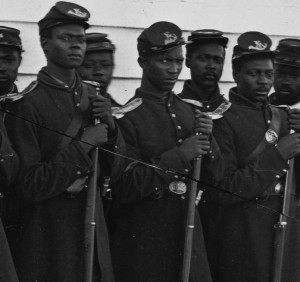 The National Archives has put together a great collection of materials highlighting the role that African-American soldiers played in the Civil War. Documents include letters highlighting the treatment of black prisoners of war by the Confederates, partial service records for Frederick Douglass’s sons, and partial service records for Sgt. William Carney, who received a Medal of Honor. No suggested grade levels were present on the website, so it is left up to individual teachers to create the level of difficulty appropriate for students.
The National Archives has put together a great collection of materials highlighting the role that African-American soldiers played in the Civil War. Documents include letters highlighting the treatment of black prisoners of war by the Confederates, partial service records for Frederick Douglass’s sons, and partial service records for Sgt. William Carney, who received a Medal of Honor. No suggested grade levels were present on the website, so it is left up to individual teachers to create the level of difficulty appropriate for students.
The activities included not only analyze the primary sources in terms of content with a provided worksheet, but ask students to synthesize and apply the information in one of four possible scenarios. Over all, the lesson activities are a bit weak when compared to the type of documents provided, yet under the heading ‘Further Research’ the lesson plan suggests students read and analyze Robert Lowell’s poem “Colonel Shaw and the Massachusetts’ 54th” (also known as “For the Union Dead,” available here) which is a great way to create an interdisciplinary lesson.
On the other hand, if one is looking for other ideas, the Civil War Preservation Trust offers a lesson plan on the United States Colored Troops, for grades six through eight. Using enlistment papers for a colored solider as well as two period illustrations, it guides teachers through several activities that ask students to describe, explain, and analyze information. The lesson plan is well thought out and can easily be supplemented with the documents made available by the National Archives.
22
Feb
10
Broadsides Collection
Posted by sailerd Published in 19th Century (1840-1880), Images, Letters & Diaries Themes: Battles & SoldiersThe University of South Carolina has a nice digital collection of over two hundred broadsides from the Colonial Era to the present. One can find broadsides related to secession, the Civil War, and a number of other topics. Almost all of the broadsides in this collection were originally printed in South Carolina. Other digital collections are available through the South Carolina Digital Library.
19
Feb
10
Robert C. Caldwell Collection
Posted by sailerd Published in Civil War (1861-1865), Letters & Diaries Themes: Battles & Soldiers, Women & FamiliesThe Robert C. Caldwell Collection at East Carolina University offers an interesting perspective on life in the South during the Civil War. The collection consists primarily of Robert Caldwell’s letters to his wife between August 1863 and February 1865. He served with the 10th Battalion North Carolina Heavy Artillery, which remained in eastern North Carolina until they were sent to Georgia November 1864. Caldwell owned slaves, but by June 1864 he hoped that “this cruel war” would end and “let…Soldiers return home to our love ones in pece [sic].” In addition, this collection includes several letters from members of his extended family – Private Amzi Harris, who served in the 9th Mississippi Volunteer Regiment, wrote two letters in late 1861 that described Confederate operations in Florida. Mary W. Driskill, who lived on a farm in Georgia with her daughter, explained the hardships she faced while her husband served in the army.
17
Feb
10
The New South Newspaper (1862 -1866)
Posted by sailerd Published in Civil War (1861-1865), Historic Periodicals Themes: Battles & Soldiers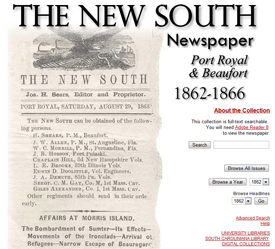 The Port Royal New South (1862-1866) offers an interesting perspective on life in the South Carolina lowcountry during the Civil War. The editors published the first issue of their weekly paper in March 1862, which was several months into the Union’s occupation of Port Royal. While it promised to “abstain from the discussion of exciting political topics,” the paper’s ultimate objective was “to strengthen the hands of the government and those who represent it.” This collection, which is available from the University of South Carolina, requires Adobe Reader in order to view any of the newspapers. A number of other interesting digital projects are also available.
The Port Royal New South (1862-1866) offers an interesting perspective on life in the South Carolina lowcountry during the Civil War. The editors published the first issue of their weekly paper in March 1862, which was several months into the Union’s occupation of Port Royal. While it promised to “abstain from the discussion of exciting political topics,” the paper’s ultimate objective was “to strengthen the hands of the government and those who represent it.” This collection, which is available from the University of South Carolina, requires Adobe Reader in order to view any of the newspapers. A number of other interesting digital projects are also available.
16
Feb
10
North Carolina and the Election of 1860
Posted by Published in Antebellum (1840-1861), Letters & Diaries Themes: Contests & Elections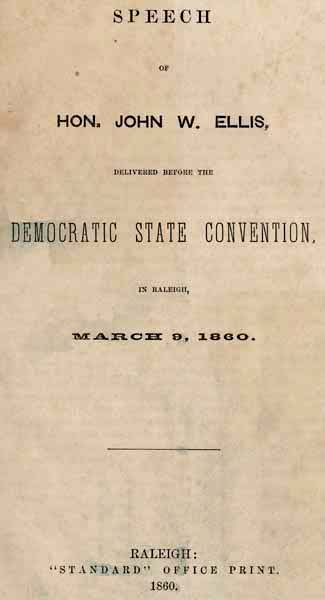 As previously mentioned in this blog, the University of North Carolina at Chapel Hill supports a fantastic website for researching all aspects of the South during the Civil War era called Documenting the American South. On this website, there are several important resources that relate to the crucial election of 1860. A simple search of the collection for the term “election of 1860” does not yield much relevant information; therefore, as is often the case, the subject index is more useful for finding these materials. In this instance, the best materials are found under the heading United States — Politics and Government — 1857-1861. An important document found here is John Willis Ellis’s speech at the 1860 North Carolina Democratic Convention. It presents a look into the Democratic party in North Carolina leading up to the election of 1860. While the speech was an acceptance of his party’s nomination for a second term as governor, Ellis focused on national issues in his address. He attacked William H. Seward, then running for the Republican presidential nomination, and called on Democrats to overlook the divisive issue of the ad valorem tax in favor of party unity. This was supported by western Democrats but opposed by eastern Democrats because it taxed slaves at lower rates. The division of the Democratic party along this (and other) lines was a deciding factor in Republican Abraham Lincoln’s election to the presidency in 1860. In this speech, Governor Ellis saw the divisions already forming in the party, however his warnings were not enough to unite the Democrats.
As previously mentioned in this blog, the University of North Carolina at Chapel Hill supports a fantastic website for researching all aspects of the South during the Civil War era called Documenting the American South. On this website, there are several important resources that relate to the crucial election of 1860. A simple search of the collection for the term “election of 1860” does not yield much relevant information; therefore, as is often the case, the subject index is more useful for finding these materials. In this instance, the best materials are found under the heading United States — Politics and Government — 1857-1861. An important document found here is John Willis Ellis’s speech at the 1860 North Carolina Democratic Convention. It presents a look into the Democratic party in North Carolina leading up to the election of 1860. While the speech was an acceptance of his party’s nomination for a second term as governor, Ellis focused on national issues in his address. He attacked William H. Seward, then running for the Republican presidential nomination, and called on Democrats to overlook the divisive issue of the ad valorem tax in favor of party unity. This was supported by western Democrats but opposed by eastern Democrats because it taxed slaves at lower rates. The division of the Democratic party along this (and other) lines was a deciding factor in Republican Abraham Lincoln’s election to the presidency in 1860. In this speech, Governor Ellis saw the divisions already forming in the party, however his warnings were not enough to unite the Democrats.
15
Feb
10
Conference Commemorating the 150th Anniversary of the Harpers Ferry Raid
Posted by sailerd Published in Antebellum (1840-1861), Video Themes: Slavery & Abolition“John Brown, Slavery, and the Legacies of Revolutionary Violence in Our Own Time,” a conference held in October 2009 at the Gilder Lehrman Center for the Study of Slavery, Resistance, and Abolition (Yale University), is now available online. Over twenty scholars participated in this event, which included four different sessions – “John Brown: A Problem in Biography,” “John Brown and the Arts,” “John Brown and the Legacies of Violence,” “John Brown and Abolitionism.” One can also watch the keynote address (W. Fitzhugh Brundage) and the concluding roundtable (David Blight, Russell Banks, and Tony Horwitz). More information about all of the conference participations is available here. Videos from several other events at the Gilder Lehrman Center are also online, including a discussion with historians David W. Blight Drew Gilpin Faust about Faust’s recent book, The Republic of Suffering: Death and the American Civil War (2008).
13
Feb
10
Seeing Slavery in a Digital Age
Posted by Matthew Pinsker Published in Antebellum (1840-1861), Rare Books Themes: Slavery & Abolition One of the great wonders of the digital age is the ability to read rare books and documents from your desktop. Admittedly, reading online isn’t always easy or fun, but nothing compares to ease of access or the ability to search the full text of these resources. A great case study for this brave new world lies with the study of slavery. There are now thousands of ex-slave narratives, pro- and anti-slavery pamphlets and important nineteenth-century accounts of the peculiar institution, such as Frederick Law Olmsted’s Journey in the Seabord Slave States (1856) that can be searched and researched at greater speed and with more diverse perspectives than ever before. Two of the best digital collections of slavery-related materials are from the University of North Carolina Library’s prize-winning Documenting the American South website and also a newer site called Slavery & Abolition in the US from Dickinson College and Millersville University. Both feature a wide variety of primary source texts that can be searched fruitfully for references to particular topics. For example, a persistent and creative student can look for and find references to antebellum plantation practices or customs such as childhood experiences, relationships with plantation mistresses or the practice of Christianity by slaves. They can compare how abolitionists and pro-slavery pamphleteers argued over “wage slavery” and the treatment of northern workers. Naturally, all of this and much more research has been done before the advent of the Internet, but full-text searching makes such projects much easier. Students in my Civil War class are preparing to launch their own projects on slavery. I hope they will use this blog post to demonstrate my point by commenting on some initial connections they have made between two or more sources in either the DocSouth site or the Slavery & Abolition collection. Please feel free to share quotations and links from rare books that contain insights on the institution of slavery or about the fight over its continued existence in nineteenth-century America. Also, please feel free to report on any frustrations or challenges in using either of these digital collections. They are helpful, but they are not perfect. And, of course, any other readers of the blog should feel encouraged to jump in with their own observations and reports from the front-lines of research and teaching in a digital age.
One of the great wonders of the digital age is the ability to read rare books and documents from your desktop. Admittedly, reading online isn’t always easy or fun, but nothing compares to ease of access or the ability to search the full text of these resources. A great case study for this brave new world lies with the study of slavery. There are now thousands of ex-slave narratives, pro- and anti-slavery pamphlets and important nineteenth-century accounts of the peculiar institution, such as Frederick Law Olmsted’s Journey in the Seabord Slave States (1856) that can be searched and researched at greater speed and with more diverse perspectives than ever before. Two of the best digital collections of slavery-related materials are from the University of North Carolina Library’s prize-winning Documenting the American South website and also a newer site called Slavery & Abolition in the US from Dickinson College and Millersville University. Both feature a wide variety of primary source texts that can be searched fruitfully for references to particular topics. For example, a persistent and creative student can look for and find references to antebellum plantation practices or customs such as childhood experiences, relationships with plantation mistresses or the practice of Christianity by slaves. They can compare how abolitionists and pro-slavery pamphleteers argued over “wage slavery” and the treatment of northern workers. Naturally, all of this and much more research has been done before the advent of the Internet, but full-text searching makes such projects much easier. Students in my Civil War class are preparing to launch their own projects on slavery. I hope they will use this blog post to demonstrate my point by commenting on some initial connections they have made between two or more sources in either the DocSouth site or the Slavery & Abolition collection. Please feel free to share quotations and links from rare books that contain insights on the institution of slavery or about the fight over its continued existence in nineteenth-century America. Also, please feel free to report on any frustrations or challenges in using either of these digital collections. They are helpful, but they are not perfect. And, of course, any other readers of the blog should feel encouraged to jump in with their own observations and reports from the front-lines of research and teaching in a digital age.

